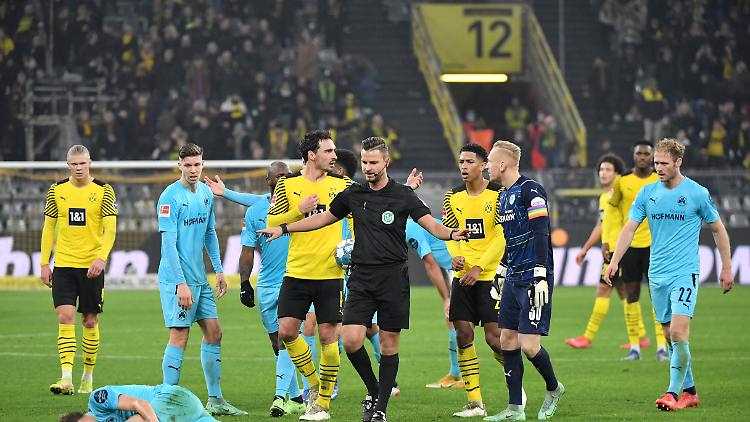Thursday, December 16, 2021
“Collina’s heirs” grumble
Tuta and Diaby finish the fairness record
By Alex Feuerherdt
When judging hand games, the referees are back on track. There are discussions about a possible offside in front of a Mainz goal and about too much indulgence for a Dortmund professional. However, a fairness record will not be expanded any further.
When the top game between Borussia Dortmund and FC Bayern Munich (2: 3) was decided on the penultimate match day by a controversial hand penalty that was given after an on-field review, the tiresome discussion about the handball issue flared up again Penalty area. Up until then, the referees had implemented the handball rule, which was changed again before the season and in which the intention is now the focus of the assessment, well and predictably. But when something works, it often receives far less public attention than the opposite.
Therefore, it should be emphasized at this point that hand games on this 16th matchday were assessed by the referees in a comprehensible and rule-compliant manner. To name the most important examples:
- In the match between Arminia Bielefeld and VfL Bochum (2-0) the ball jumped in the 86th minute after a cross into the penalty area against Joakim Nilsson’s left arm. The Bielefeld player was surprised that his opponent Anthony Losilla, who was positioned immediately in front of him, missed the ball. In addition, his arm was close to the body and in a natural position, in the end Nilsson even tried to pull him out of the trajectory of the ball. Referee Benjamin Brand let the game continue and was absolutely right.
- In the game of FC Augsburg against RB Leipzig (1: 1), a few minutes before the end in the Leipzig penalty area there was two handball by the guests, each after a corner kick: First Willi Orban deflected the ball with his arm, but he did was almost applied to the body, then Benjamin Henrichs hit the ball with the elbow of his raised and outstretched arm. Referee Florian Badstübner made the correct decision on both occasions: After Orban’s handball he let play continue, but after Henrichs’ handball he gave a penalty.
- In the match between Borussia Dortmund and SpVgg Greuther Fürth (3-0), the ball flew after half an hour in the guests’ penalty area after a shot by Erling Haaland against the extended arm of Fürth’s Maximilian Bauer. Referee Daniel Schlager hadn’t noticed the handball on the field, which is why video assistant Günter Perl intervened. That was justified, because Bauer’s arm position did not correspond to a natural, situation-typical movement. After the on-field review, Schlager therefore recognized a penalty, which was also correct.
Bellingham and Diaby get off lightly
In another situation in this game, however, the referee showed less consistency. He had rightly warned Jude Bellingham after 43 minutes when the Dortmund goalkeeper Sascha Burchert hindered and tried to deflect the defensive wall in front of a free kick, so he saved the 18-year-old shortly before the break the second yellow card, the would have meant the field reference. Bellingham had put the ball a bit too far and then played it again in the following tackle with a lot of risk, but then literally cleared the Fürth Max Christiansen with full dynamism. Yellow-red would at least have been a better decision here, because Bellingham’s commitment was ruthless.
Instead, the longest series of Bundesliga match days without expulsion since the introduction of yellow-red in the 1991/92 season ended in two other matches. In the past five game rounds, the referees did not remove a single player, now it was Tuta from Frankfurt in a 3-2 win for Eintracht in Mönchengladbach and Moussa Diaby from Leverkusen in Bayer 04’s 2-2 win against TSG 1899 Hoffenheim. Both had to leave the lawn prematurely due to repeated foul play with yellow-red.
Diaby could have seen the red card instead of the yellow card for his “wiper” in Sebastian Rudy’s face after 20 minutes. However, the rules allow the referees a certain degree of discretion in such acts. Rule 12, which deals with “Fouls and Other Misconduct” states: “A player who deliberately hits an opponent or other person in the head or face with his hand or arm without fighting for the ball, commits an assault unless the force used was negligible. ” Due to the restriction in the last half-sentence, it was just justifiable to only warn Diaby for his offense.
At the second Mainz goal there is a lot to be said for a criminal offside
In the game of 1. FSV Mainz 05 against Hertha BSC (4: 0), the home side’s second goal was a great argument. Because before Alexander Hack scored in the 41st minute, Moussa Niakhaté was offside on the previous cross in the center of the box and just missed the ball when trying to reach the ball with his foot. The hit was recognized, however, and there were no objections from the video center in Cologne. There were good arguments for evaluating Niakhaté’s behavior as influencing an opponent.
According to the rules and regulations, such an influence exists, for example, when an offside player leads a duel for the ball with an opponent, when he is clearly trying to play the ball near him and thereby influencing the opponent or when he is clearly active thus affecting the opponent’s ability to play the ball. With Davie Selke, Niakhaté undoubtedly led a duel for the ball, but the Berliner could not see the Mainz player positioned behind him. Other Herthaners nearby such as Suat Serdar and Niklas Stark, on the other hand, reacted with their defensive behavior to Niakhaté’s attempt to play the ball.
But it is possible that referee Harm Osmers and his video assistant Sascha Stegemann were not specific, not tangible enough to assess the offside position as a criminal offense. The clear, ball-oriented activity of Niakhaté and the reaction of the defenders to it, also with regard to their positioning, speak for an offside that is worthy of punishment. In another extremely tricky situation that occurred after just under an hour, the referee and the VAR were completely right.
In Stark’s foul, the referee is spot on
Niklas Stark brought down the Mainz attacker Karim Onisiwo at the edge of the penalty area with a tackle. It was extremely difficult to tell whether the foul had occurred inside or outside the penalty area. Referee Osmers located it outside – and was spot on. Onisiwo was already with his toe on the penalty area line, which is known to be part of the penalty area. But with classic contact offenses such as kicking or tripping, it depends on the exact “point of contact”, i.e. the exact location of the hit.
In this case, he was just outside the penalty area, because Stark hit his opponent with his knee on the side of the foot, which, unlike the tip of his foot, was not on the penalty area line. That may sound subtle and theoretical, but when technical aids are used to review a decision, such details are essential. And if that goes too far for you, you may be convinced by the argument that the pictures in any case do not show that the referee was wrong with his decision.

